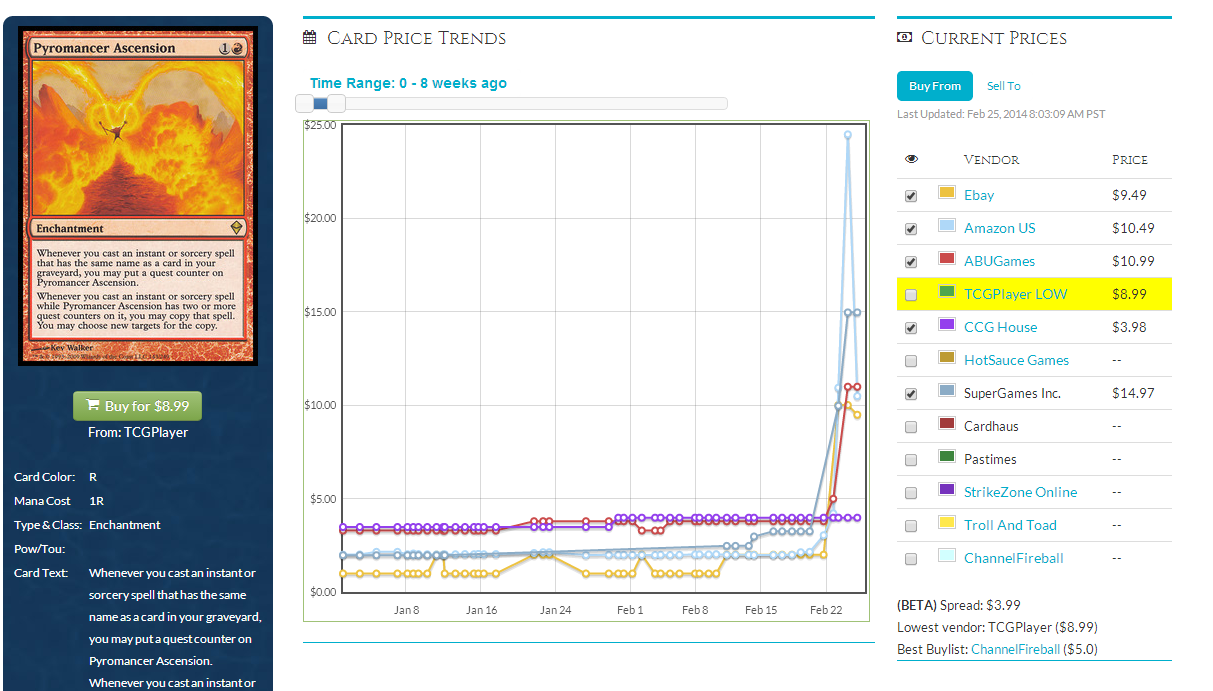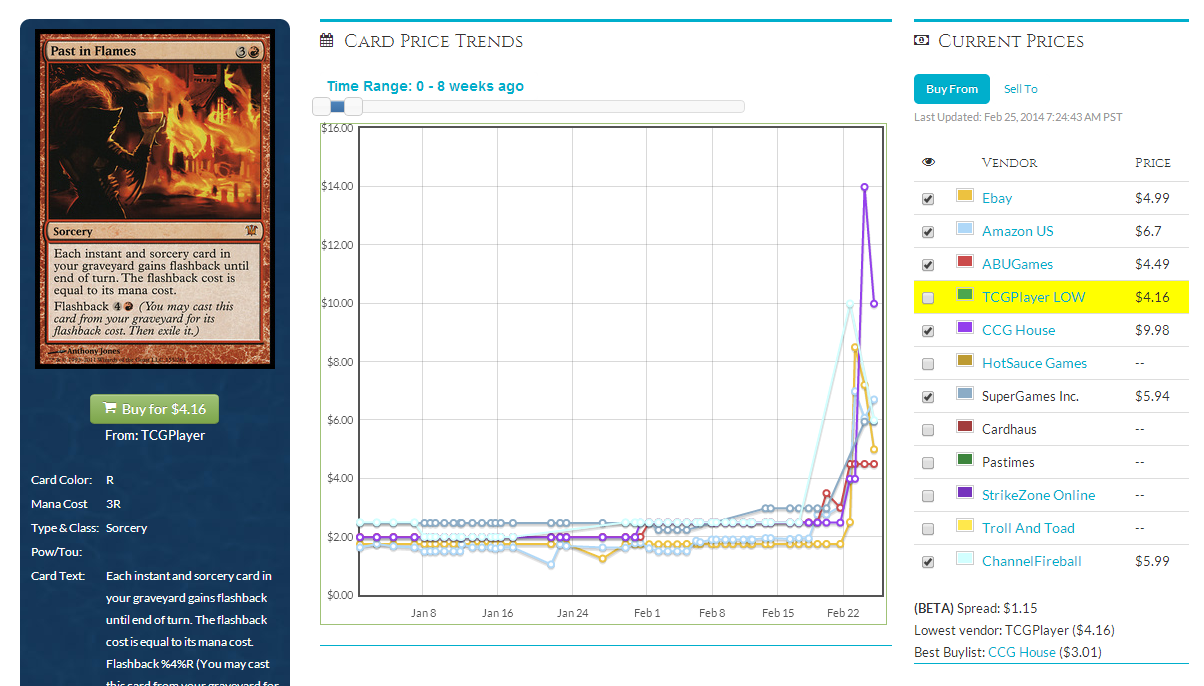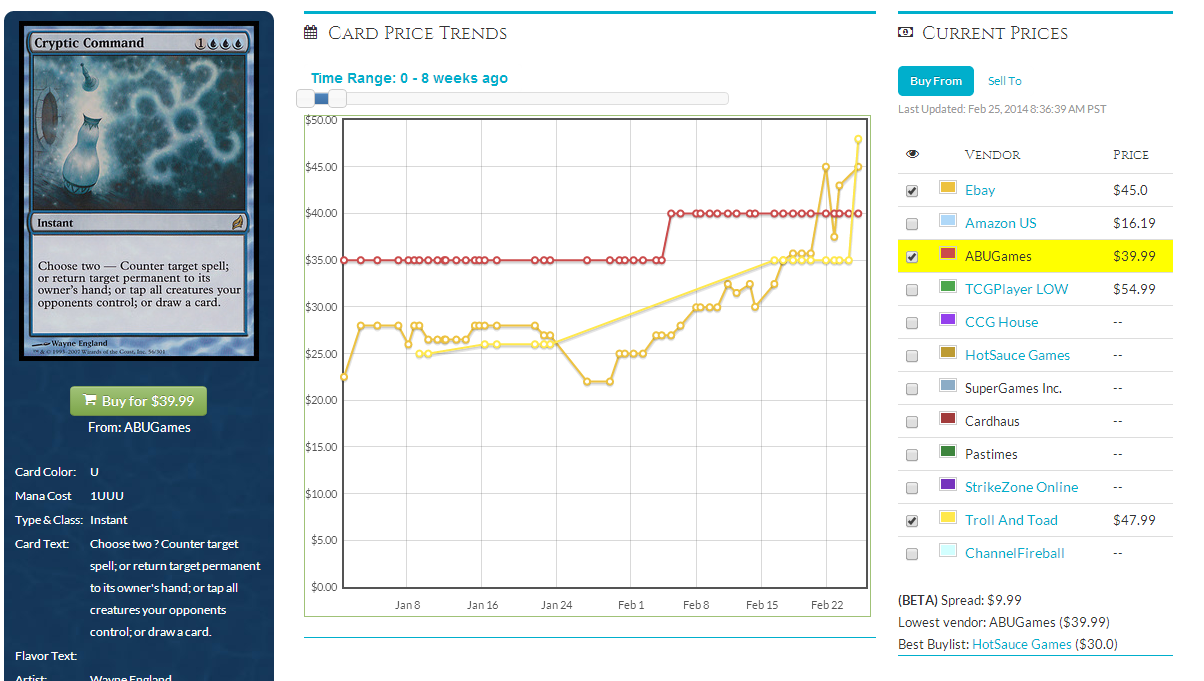By: Camden Clark
As most of you know, the Pro Tour was last week.
I, unfortunately, missed a lot of the coverage. It was kind of a busy weekend for me.
However, what I did see, I was kind of disappointed by. Most notable was the lack of Magic finance possibilities. The day three coverage (which I did watch) had almost no new archetypes, with the same pillars of the format being represented, especially in the finals.
There were the typical cards that everyone hyped around for a few hours/days on Twitter and other media outlets.
One teachable moment that featured this kind of progression is the Amulet of Vigor spike.
There were very few people playing the Amulet of Vigor deck. However, I believe it was featured on camera. Considering there were about 20,000 people watching, this one was bound to get some buzz. There was a lot of talk on Twitter. Promptly, speculators bought out a ton of copies on TCGPlayer.
I really never want to get caught up in this kind of frenzy.
A card like Amulet of Vigor is extremely narrow. What other decks do you honestly ever see Amulet of Vigor being played? Very few.
Very quickly, players realized that this deck wasn’t putting up real results and weren’t hot on buying a copy.
That got awkward quickly for the people who bought out copies of today’s Nivmagus Elemental (Now with less playability!).
In contrast, there were cards that started a slow climb and weren’t instant buyouts. Cards like Past in Flames and Pyromancer Ascension saw HUGE upticks. Let’s take a closer look.


These ones had little buzz until very late, when we saw them go up by huge margins as people started to take note of the standings that storm was placing.
But how do you discern what are good opportunities and vacuous hype?
It’s a matter of artificial and real demand.
Artificial demand is generated by speculators who jump on a card to make a profit. They only want the card to be able to turn it around and sell it quickly. There are TONS of cards in history that have seen increases after artificial demand from speculators grab up copies raising the price extremely high.
The trouble is, who are you going to sell to?
Card shops rarely increase their buylist prices on narrow cards after a buyout for this reason.
Because there are merely speculators buying out these cards, there is no way for you to liquidate. After the hype dies down, the prices go back down and you are stuck with a junk-ish card that sees little to no play.
This exact scenario happened with Amulet of Vigor.
There was a mass buyout and tons of people bought into the hope that there might be a high-placing deck to generate real demand. Rarely does this happen with a narrow card like this.
When there was no real demand, the price tapered off and the hype was gone.
Cards with real demand are what you really want to target. These cards have REAL players who are not simply looking to buy in to sell-they want to play with the cards they are buying. This means they will buy AND hold on to the cards, rather than buying to sell.
Therefore, you have opportunities to get out of your positions and make money.
There is virtually no ceiling on cards with real demand like Past in Flames. There is such a huge ability for these kind of cards to simply skyrocket as PTQ players will pay any cost to play a deck that placed well a pro tour.
How do you identify cards that can generate real demand?
It comes from your sense as a player.
The knowledge that you gain from being a magic player is not discarded in the world of Magic finance. In fact, it is the most overlooked skill of speculators.
I went over in my last article about what to do during the Pro Tour. If you were paying close attention to what people were playing, you would have noticed the LARGE group of players that were placing with Storm decks. You would have been able to make the call on buying those storm staples and making a profit on them.
It’s all about being in tune with your skills as a Magic player and applying those to making (or saving) money.
When I speak of real demand, it’s also encyclical. Many PTQ grinders or simply ones who want to play in their local PTQ either don’t have the foresight or can’t capitalize on it to see what their needs are going to be in the future.
But you can and should see beyond this.
I don’t think Wizards will change the format at the next B&R announcement. You should take this format as it is. Even if there is a B&R announcement when Journey into Nix comes out, you will still be set if you run with format staples to invest in.
The Pro Tour provided the foundation for this new format. Pro players will look back to THIS point to analyze what cards and decks are good, opposed to which aren’t. Moreover, this is a guidepost to the format staples that you should be looking at.
This is the breaking point for Modern. Before, very few people would play this format. However, with PTQ season approaching, more and more people are going to want to play these powerful decks. They will want to bling them out. That is REAL demand.
The best opportunities in modern are going to be long term. This is the starting point. This is where you enter into the market and make the decisions to invest in the cards that have a VERY low chance of going down.
That’s investing that we can all get behind.
What format staples are examples of this?
I feel like I’m beating a dead horse on this one. It’s too low. It won’t go any lower. Even if it stays the same price, it’s easy to liquidate and is an extremely popular card. It has playability in the UWR Twin deck, Kiki-Pod, and a few other decks. You can move in on this one now.
At the bottom of my previous article I staunchly defended that Modern staples have little ceiling. I will still defend this, and now with a little proof.

Take a look at that increase going into the Pro Tour. There might be a quick price decrease as the hype from the pro tour dies down. That’s when you want to move in on this card. I still think 50 dollars is a conservative estimate; this could see 60 dollars.
I’m serious: Modern is here to stay. Wizards is putting too much effort in this format for it to fail. It’s time to ride the ride with WOTC.
The price of this card is bonkers right now. It’s worth talking about though.
I didn’t pick this card last week, and I’m not sure why. In hindsight, this is one of the best possible picks. It’s a pillar of the format and widely playable. Look for the hype to die back down and buy in. This card will never go down because it sees legacy play.
It’s not too late for this one – the prices have stayed relatively the same. I don’t really know why, and I think it has something to do with the real demand being absent. This seems like so much of a no brainer to speculators that they fail to invest in it. This card isn’t getting any lower, you should definitely be in the market to pick these up.
Splinter Twin isn’t going away. There were 12 copies in the top 8 of the Pro Tour. I’m a buyer under 20, it’s hilariously cheap.
Even though these are my main picks, there are tons of other opportunities. You have to do your own analysis and determine what YOU think as a player are the hot new cards. I can’t tell you what all the best cards are and see into the future, but we can have a chat on Twitter. I love talking about Magic; if you have any questions, feel free to hit me up.
So long for now, and good luck going into Modern season in the next few months.
I think you underestimate the demand for “tier 2” cards. There’s a lot of people who like to play decks that are somewhere between casual and competitive – they like to play in competitive formats but not necessarily with super competitive decks. There’s an opportunity there for speculation – anyone who put a lot of money into norin the wary when it was less than a dollar made a killing. Anybody who bought amulets of vigor at 2.50 or less should have no problem making a profit
This is a good point. Decks like 8-Rack and Burn are still reasonably good and much cheaper than a deck like American Control (which is almost $1400). Even in serious tournaments, cost can be a factor, especially with younger players.
I love to share understanding that will I’ve built up through the calendar year
to help improve team overall performance.
my webpage … SEO